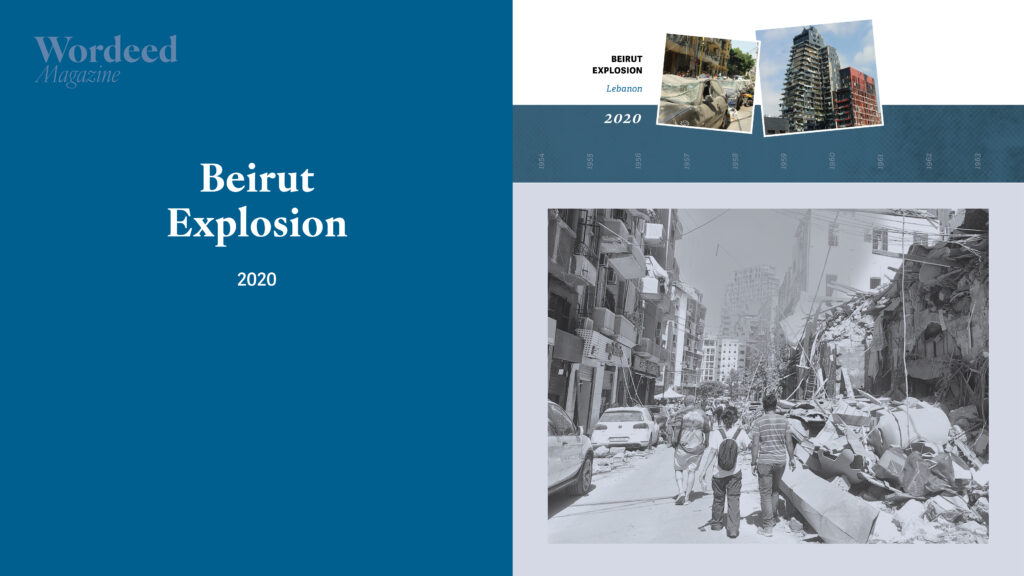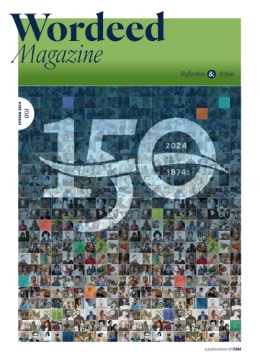Retronyms and neologisms —not exactly the flashiest words to begin an article for CBM. Online dictionaries define the two words thus:
A retronym is a newer name for an existing thing that helps differentiate the original form from a more recent one. It is thus a word or phrase created to avoid confusion between older and newer types, whereas previously (before there were more than one type) no clarification was required. Example: We drank our regular coffee with whole milk and ate organic food as we listened to an acoustic guitar.
A neologism is a relatively recent and isolated term, word, or phrase that nevertheless has achieved some popular recognition. Example: Hunkered down during a snowmaggedon, we laughed at memes and ate our vegan brunch.
When we describe CBM’s “preferred” option in sharing the gospel, we tend to use a retronym—Integral Mission—and occasionally sneak in a neologism—Wordeed.
Canadian Baptists have been on this journey for more than 150 years, when valiant servants of God responded to his call to mission beyond our borders prior to the existence of a mission board. They left their homes and loved ones, crossed oceans and mountain ranges, learned new languages and customs, to reach the lost. Just how did those early missionaries, and more recently, Field Staff, engage people groups in cross-cultural mission?
Consider these two lists of words;
Preaching Demonstrating
Word Deed
Proclamation Presence
Justice Mercy
Mouth Hands
Evangelism Social action
Converting Healing
Faith Works
Salvation Development
Believing Living
Saying Doing
Soul care Social care
Certainly, some of our forebearers were drawn more to one expression of Christian witness, while others, sometimes on the very same team or working in the same region of the world, opted for the other.
One such example is Jane Buchan (1837–1904) who rallied countless women in Canada to assume a critical place in the mission of the Church, including education and human rights. In 1876, Jane and her sisters helped create the Women’s Baptist Foreign Missionary Society of Ontario West and launched a periodical, the Canadian Missionary Link. A keen activist in missionary activity, Jane focused on India where the work had a strong social engagement.
Buchan advocated against the practice of Sati, where widows were burned alive on the funeral pyres of their deceased husbands. She wrote against the caste system and promoted outreach and development among the lowest caste (Dalits, or the untouchables). Over the years, she helped raise thousands of dollars for development projects such as dispensaries, schools, and shelters for women. By the time of her death, Baptist women in Ontario were supporting 14 female missionaries in India and a new field in Bolivia was being opened.
Like others of her generation, Jane was a practitioner of integral mission, long before the term was coined. She was part of a movement of believers whose passion was lit for a newer, more holistic understanding of God’s mission in the world. Many Canadian Baptists at the time were accused of touting a “social gospel” by being overly concerned with the welfare of people, when some felt the priority should have been placed on “the conversion of souls”.
At that time, many Baptists were anxious to distance themselves from this group and get “back to the fundamentals”. They were part of the revivalist movement of the 19th and early 20th century that focused on personal salvation and individual spirituality. Church historian, Timothy L. Smith, coined the term “The Great Reversal” to describe the about-face many evangelicals made from a sense of deep social concern for others to a focus on personal and private salvation. They feared that with the rise of the social gospel movement, the Church would be over-run with liberal theology.
An intense debate was waged concerning the priorities of Christian mission.
As Canadian Baptist missions activities grew—first in India, then Bolivia, and by the late 1950s, in Angola and the Congo—some missionaries held an unwavering zeal for preaching the gospel while others were passionate about the humanitarian dimension of their faith. Christians advocated for human rights, religious freedom, vocational training programs, and land reform acts, such as in Bolivia where Canadian Baptist missionaries championed the rights of local farmhands to own the land they worked. But for some, the zeal for humanitarian service began to outweigh the passion and enthusiasm of reaching the world for Christ. They felt that traditional forms of evangelism had neglected a thoughtful engagement with culture.
There was a time CBM’s office building in Mississauga had two different colours of carpet. On one side of the building was the relief and development ministries, The Sharing Way: they had green carpet. They had amazing programs in food aid, maternal health, soil improvements, microcredit, and vocational training. They were founding members of Canadian Foodgrains Bank, which today, still seeks to offer a Christian response to global hunger.
The other side of the building housed those involved with evangelism, church planting, discipleship programs, theological education, and Christian literature: they had red carpet. Along the halls of each side of the building were maps and pictures, showing places and people whose lives were being impacted by noble and valuable Christian mission.
Though very real, the different carpet colours are a metaphor of the state of the Church by the second half of the 20th century. For some, mission was the work of building healthy local churches and equipping leaders for gospel ministries. For others, mission was about alleviating the suffering of the world’s poor. But why did this division exist? Is it right that we had separated the two dimensions of Christian witness?
In 1982, Rev. Bob Berry wrote a poignant article in Enterprise Magazine entitled “Mission: What It Is and What It Isn’t”, in which he invited the readers, in light of the Great Commission and the Great Commandment to consider the Great Definition. He juxtaposed Dr. Donald McGavran’s stance, “The highest priority (is) bringing men into living relationship with Jesus Christ…(by) proclaiming Jesus Christ and persuading men to become disciples and dependable members of His church,” and Dr. J. G. Davies position that “mission is concerned with overcoming industrial disputes, with the surmounting of class divisions and the eradication of racial discrimination.”
For Rev. Berry and other church leaders, the truth lies in a “both-and” position, and he invited Canadian Baptists to embrace John Stott’s position that “Mission describes…everything the church is sent into the world to do.”
A Retronym is Born
In 1974, Christian leaders gathered to establish a new direction in world evangelization resulting in The Lausanne Covenant. It forged a new articulation of the interconnectedness of evangelism and social action.
Although reconciliation with other people is not reconciliation with God, nor is social action evangelism, nor is political liberation salvation, nevertheless we affirm that evangelism and sociopolitical involvement are both part of our Christian duty. For both are necessary expressions of our doctrines of God and man, our love for our neighbor and our obedience to Jesus Christ…The salvation we claim should be transforming us in the totality of our personal and social responsibilities. Faith without works is dead.1
Over and against this background, and with the unexpected voice of the Church in the Majority World, the movement towards integral mission began to take root.
In the mid-1980s, the Latin American Theological Fraternity, which included René Padilla, were challenged by the teachings of Latin American Catholic theologians who emphasized that Jesus’ salvation included liberation for the poor and oppressed. They saw the local church as an agent for positively transforming the wider world, in response to the Good News.
The Spanish term “misión integral” was coined in the 1970s by Padilla and others. It described an understanding of Christian mission that embraced both the proclamation and the demonstration of the Good News of Jesus Christ. They chose to use the word “integral” to signal their discomfort with conceptions of Christian mission that had separated evangelism from social involvement or responsibility. Padilla pointed out that the concept of integral mission is nothing new—rather, it is rooted in Scripture and exemplified in Jesus’ own ministry.
The Latin American Theological Fellowship was concerned with the dichotomy between the life of the Church and its mission. Mission was not just about sending people to overseas ministry. If the local churches back home “should just give, pray, and stay out of the way,” then mission inevitably ceased being at the centre of the Church’s purpose—it lost its place as being God’s intention for redeeming and transforming all of creation.
Padilla wrote, “When the Church is committed to Integral Mission and to communicating the Gospel in everything it is, does, and says, it understands that its goal is not to become large numerically, nor to be rich materially, nor powerful politically. Its purpose is to incarnate the values of the Kingdom of God and to witness to the love and justice revealed in Jesus Christ, by the power of the Holy Spirit, for the transformation of human life in all its dimensions, both on the individual and the community level.”
The purpose of mission is transformation, so that God is glorified in all dimensions of life including relationships with God, others, and creation itself. The goal of evangelism is not simply conversion but the creation of a new community that confesses Jesus Christ as Lord of all aspects of life and that lives out this confession in word and deed.
Padilla pointed out that central to integral mission is a concern with all the basic needs of people including God’s grace, loving relationships, shelter, clothing, mental and physical health, and the sense of human dignity. Human life in its very essence (according to the Scriptures) is body, soul, and spirit. Accordingly, the mission of God cannot be reduced to so-called “spiritual” needs such as forgiveness or to physical needs such as adequate nutrition.
Integral mission goes beyond our actions or our words and integrates our entire being. It is the Church living out its faith in Jesus in every aspect of life and witness.
WORDEED : CBM’s Neologism
When CBM released a short “primer” on integral mission in 2013, we coined the term Wordeed, as the convergence of two seemingly distinct but indissociable dimensions of God’s mission in the world. Inspired by the vision of the Prophet Micah, who, almost 3,000 years ago, called God’s people to ethical engagement and witness, we adopted the principles and practices laid out by the Micah Network (a global Christian network of organizations and individuals) which defines integral mission this way:
Integral mission or holistic transformation is the proclamation and demonstration of the gospel. It is not simply that evangelism and social involvement are to be done alongside each other. Rather, in integral mission our proclamation has social consequences as we call people to love and repentance in all areas of life. And our social involvement has evangelistic consequences as we bear witness to the transforming grace of Jesus Christ… As in the life of Jesus, being, doing and saying are at the heart of our integral task.
The term might be new, but the idea isn’t new at all. There are many examples—both modern and historical—that illustrate integral mission, or Wordeed. Ultimately, the local church is the primary means by which God works out his mission purposes. Your church, in partnership with all other local churches, has been created to carry forward the ministry of Christ. Like Jesus and his first followers in the early church and throughout the last 2,000 years, we are called to be the heart, hands, and voice of God in the world. We do so, through integral mission. And the journey has just begun.
1 https://lausanne.org/statement/lausanne-covenant?gad_source=1#cov




